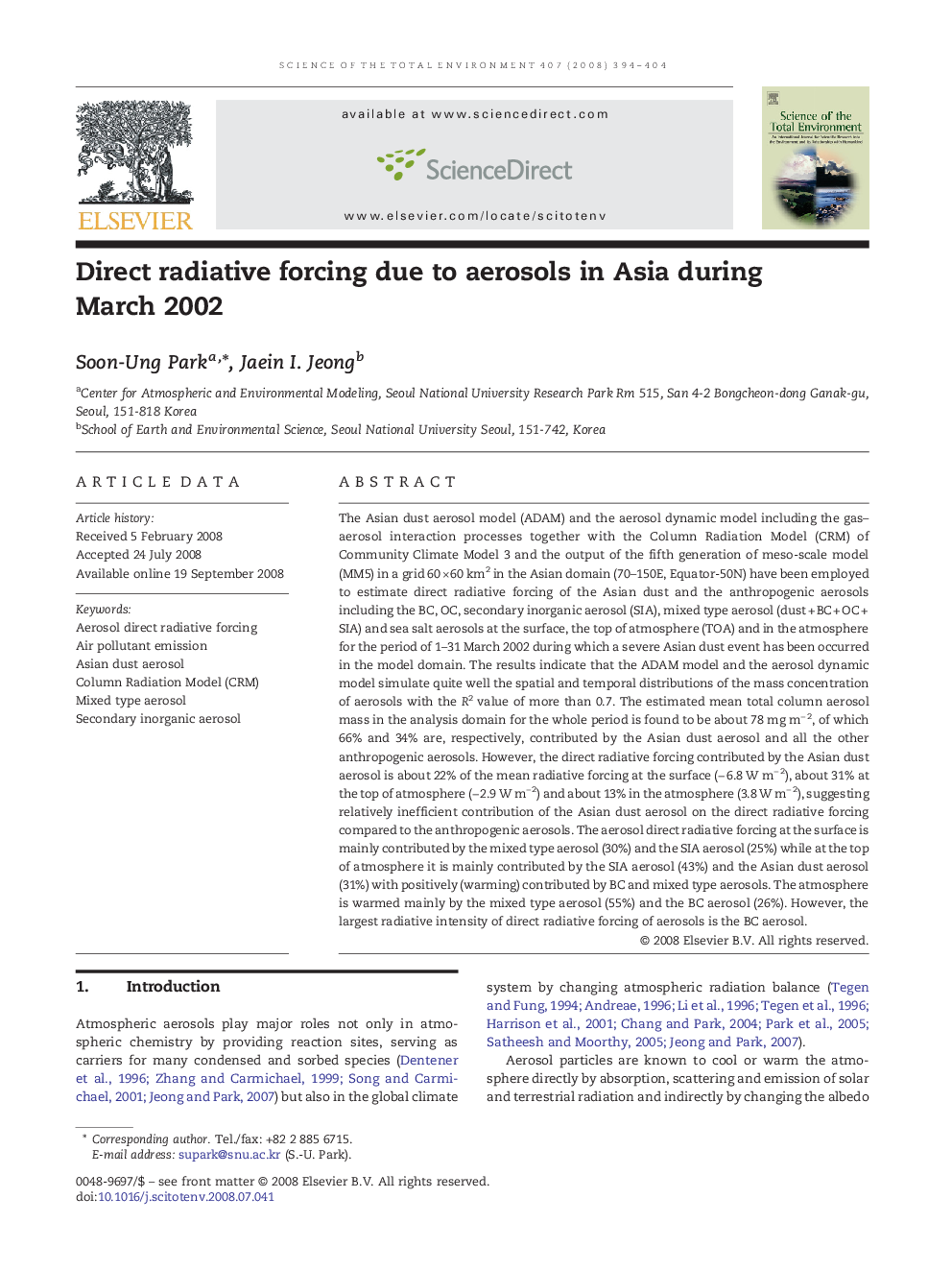| کد مقاله | کد نشریه | سال انتشار | مقاله انگلیسی | نسخه تمام متن |
|---|---|---|---|---|
| 4432496 | 1619909 | 2008 | 11 صفحه PDF | دانلود رایگان |
عنوان انگلیسی مقاله ISI
Direct radiative forcing due to aerosols in Asia during March 2002
دانلود مقاله + سفارش ترجمه
دانلود مقاله ISI انگلیسی
رایگان برای ایرانیان
کلمات کلیدی
موضوعات مرتبط
علوم زیستی و بیوفناوری
علوم محیط زیست
شیمی زیست محیطی
پیش نمایش صفحه اول مقاله

چکیده انگلیسی
The Asian dust aerosol model (ADAM) and the aerosol dynamic model including the gas-aerosol interaction processes together with the Column Radiation Model (CRM) of Community Climate Model 3 and the output of the fifth generation of meso-scale model (MM5) in a grid 60 Ã 60 km2 in the Asian domain (70-150E, Equator-50N) have been employed to estimate direct radiative forcing of the Asian dust and the anthropogenic aerosols including the BC, OC, secondary inorganic aerosol (SIA), mixed type aerosol (dust + BC + OC + SIA) and sea salt aerosols at the surface, the top of atmosphere (TOA) and in the atmosphere for the period of 1-31 March 2002 during which a severe Asian dust event has been occurred in the model domain. The results indicate that the ADAM model and the aerosol dynamic model simulate quite well the spatial and temporal distributions of the mass concentration of aerosols with the R2 value of more than 0.7. The estimated mean total column aerosol mass in the analysis domain for the whole period is found to be about 78 mg mâ 2, of which 66% and 34% are, respectively, contributed by the Asian dust aerosol and all the other anthropogenic aerosols. However, the direct radiative forcing contributed by the Asian dust aerosol is about 22% of the mean radiative forcing at the surface (â 6.8 W mâ 2), about 31% at the top of atmosphere (â 2.9 W mâ 2) and about 13% in the atmosphere (3.8 W mâ 2), suggesting relatively inefficient contribution of the Asian dust aerosol on the direct radiative forcing compared to the anthropogenic aerosols. The aerosol direct radiative forcing at the surface is mainly contributed by the mixed type aerosol (30%) and the SIA aerosol (25%) while at the top of atmosphere it is mainly contributed by the SIA aerosol (43%) and the Asian dust aerosol (31%) with positively (warming) contributed by BC and mixed type aerosols. The atmosphere is warmed mainly by the mixed type aerosol (55%) and the BC aerosol (26%). However, the largest radiative intensity of direct radiative forcing of aerosols is the BC aerosol.
ناشر
Database: Elsevier - ScienceDirect (ساینس دایرکت)
Journal: Science of The Total Environment - Volume 407, Issue 1, 15 December 2008, Pages 394-404
Journal: Science of The Total Environment - Volume 407, Issue 1, 15 December 2008, Pages 394-404
نویسندگان
Soon-Ung Park, Jaein I. Jeong,